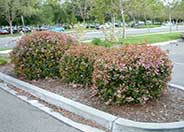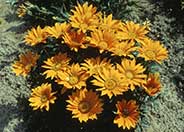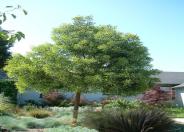
Common name:Glossy Abelia
Botanical name:Abelia X grandiflora
Abelia X grandiflora is a semi-evergreen shrub of medium size. It has small, white, fragrant flowers that bloom from spring through the fall season. Bracts add a bronzy tint to the flowers. Abelia makes a good sheared hedge or screen. When unsheared, it is naturally arching.

Common name:Hidcote English Lavender
Botanical name:Lavandula angustifolia 'Hidcote'
This is a slow growing lavender that grows to 2-3' tall with deep purple flowers. It is drought tolerant and attracts hummingbirds and butterflies.
Maintenance Tips
Lavandula angustifolia 'Hidcote' is a smaller hybrid of the English Lavender and is often found in California native gardens. It is a woody shrub with a nice round form. It grows 2-3’ tall and wide and has flower stalks that emerge above the foliage in the spring. The foliage and blooms are very fragrant and are a magnet for bees and butterflies. To keep the maintenance as low as possible, plant it in a sunny location with the space to reach its full mature size. Once the flowers have faded, the spent stalks can be deadheaded to keep the shrub looking tidy and encourage additional flowers. This shrub can take a more aggressive hedging, cutting back by about a third in the winter to keep the round shape.
Common name:Hybrid Gazanias
Botanical name:Gazania hybrids
These ground covers will grow less than 1' tall and have medium size, gray green leaves with gold, lavender, orange, red, yellow, or white flowers that are present all year.

Common name:Strawberry Madrone
Botanical name:Arbutus unedo
Strawberry Madrone (Arbutus unedo) is a small-to-medium multi-trunk tree that matures at 35’ tall and 35’ wide. It has reddish-brown bark and deep green foliage. It is a great low-maintenance tree when given the space to reach maturity. This tree is appropriate in almost any garden setting with full sun and well-drained soil. It is drought-tolerant and is very attractive to wildlife, especially bees and birds. It has clusters of small, white or greenish-white, urn-shaped flowers and small, red and yellow fruit with a strawberry-like texture from which the common name is derived. This species does not have a fast-growth habit, but it does take on a dense shrub form if it is not thinned out. In the first few years, it can easily be pruned using the thinning method to cut out cross branches and other branches that are heading off in an undesirable direction. Once the plant has reached 10' tall, a licensed arborist should perform the pruning and maintenance. This tree should be planted at least three feet away from any hardscape areas, five feet from structures such as houses and buildings, and not near any powerlines. Shrubs and perennials should be planted about two feet away from this tree. It should be irrigated for about 45 minutes once a week when using most in-line drip irrigation systems.
Designer: Rob Moore
Photographer: GardenSoft
Practice grass-cycling by leaving short grass clippings on lawns after mowing, so that nutrients and organic matter are returned to the soil.
Drip and other smart irrigation delivers water directly to roots, allowing no excess water for weeds.